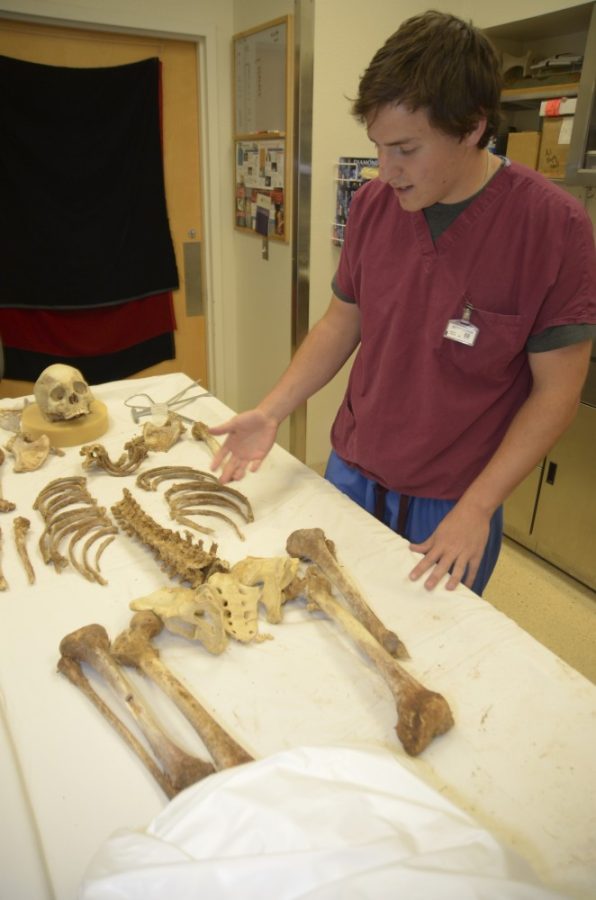Being able to identify all the bones in the human body is simple for Harrison Redd. And, as a forensic anthropologist intern, he uses this knowledge to provide closure for families of missing people.
Since 2004, the Pima County Office of the Medical Examiner-Forensic Science Center has worked in conjunction with the UA’s Department of Anthropology to offer an internship for students interested in forensic anthropology, said Bruce Anderson, a forensic anthropologist for the Forensic Science Center.
Redd, an anthropology junior, is one of three students selected to participate in the internship and help identify bodies found in Southern Arizona.
“It’s something unique and not a lot of people get the chance to do,” Redd said. “I wanted this internship because I saw it as a great service to help match people to loved ones and show them people cared enough to try and find them.”
Forensic anthropology combines physical anthropology and osteology, the study of bones. Forensic anthropologists often work with pathologists and law enforcement to identify human remains. They are able to do so by examining skeletal samples of the deceased to determine sex, age, dental history, ethnicity, possible cause of death and any unique characteristics.
“The medical examiners, or pathologists, realized that with all of the expertise they had they still don’t have the same knowledge a Ph.D. anthropologist will when it comes to the human skeleton,” Anderson said. “So in jurisdictions like Pima County where there are a lot of cases where bones need to be analyzed because the rest of the body is no longer present, that is where a forensic anthropologist really does most of their work.”
The Walter H. Birkby Forensic Anthropology Library is a small laboratory located in the Science Center. There, Redd spends 10 hours a week collecting information on unidentified people. In a room big enough for one metal table and a computer, Redd cuts bone samples from the skeleton, takes dental X-rays and examines skulls and femurs for trait characteristics. All samples are then sent to another lab for DNA analysis and to be put into a database.
“We try to get as much information as we can to build a biological profile that we can put on a missing person report.” Redd said. “This way we can try to make that connection and find out who the person is.”
Redd has not only worked with skeletons, but bodies that still contain tissue as well. Though he has never had a problem working on these cases, he said he gets mixed reactions from his family and friends after they hear what he does in the lab.
“It was a little shocking the first couple of days, turning a corner and realizing people are performing autopsies,” Redd said. “But you get used to it and have to realize it is an experience and I have learned so much.”
Because the lab receives about 200 remains a year due to migrant deaths in the desert, the office often uses interns to help assist in the information gathering, said Angela Soler, a forensic anthropologist and student adviser for the Forensic Science Center.
“It is great to see enthusiasm in students who are interested in this field and they have been a big help in taking X-rays and cleaning bones,” Soler said. “Having interns who are not afraid to do what they need to do is great.”
In the past 10 years, there have been more than 2,000 recorded immigrant deaths in Pima, Pinal and Santa Cruz counties, according to Anderson. Pima Country is one of the few counties in the country to employ a full-time forensic anthropologist to work on these cases and help identify bodies.
Out of the 2,000 deaths, the Forensic Science Center has been able to identify 1,300 remains, 93 percent of which were Mexican citizens, Anderson said. In addition to this, the Forensic Science Center also helps relocate Native American remains to their proper tribes or cultural affiliates.
“Most jurisdictions don’t need a full-time forensic anthropologist,” Anderson said. “And it is a good idea to show students who have an interest the kind of work what we do here in Tucson.”
Redd said he eventually wants to attend graduate school and learn more about forensic science. His experience in the lab has pushed to continue to help solve forensic cases.
“I know that by me getting information and putting it into a database we get the chance to give remains back to families who have no idea what happened to their loved ones,” Redd said. “It gives them closure.”









